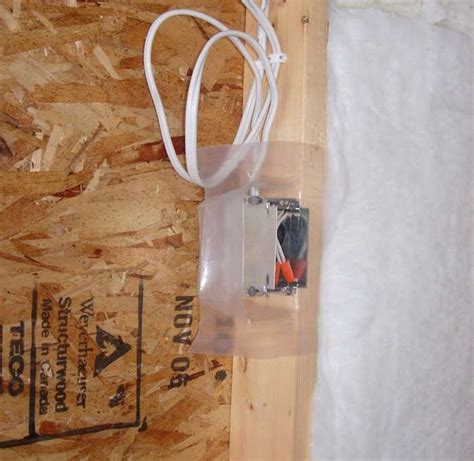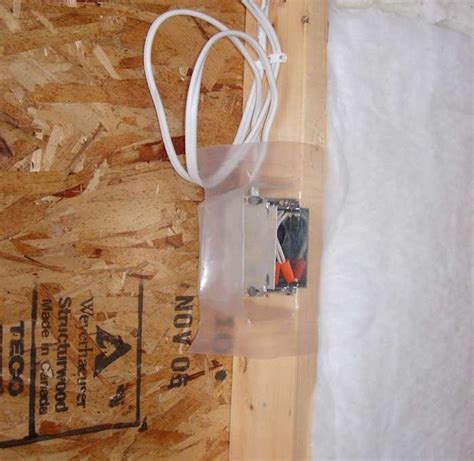air seal electrical boxes Air seal around all electrical wiring and electrical boxes installed through walls, ceilings, and flooring to prevent air leakage and moisture movement between unconditioned and conditioned space. Knowing the full process of stick welding will enable you to weld a piece of thin metal well. Below I have described the full process step by step of thin metal welding. Welding is a sensitive job. So have the necessary tools and protective equipment before welding.
0 · vapour barrier electrical box installation
1 · vapor barrier for electrical outlet
2 · vapor barrier for electrical boxes
3 · vapor barrier around electrical boxes
4 · lessco air vapor barrier box
5 · how to seal electrical outlets
6 · how to insulate electrical boxes
7 · air sealing electrical outlets
Shown here is the #10 sitting on top of a wall mounted Type 5 magneto box, wired to a #13 induction coil that is rack mounted and #43F extension ringer. This is an example of how one might find a WE #10 before or around 1900. The Type 5 .
Air seal around all electrical wiring and electrical boxes installed through walls, ceilings, and flooring to prevent air leakage and moisture movement between unconditioned and conditioned space.The new, unique hinge design makes virtually all standard single, double, triple and ceiling electrical boxes compatible with the new and improved LESSCO AVB Box. And you can now . Air-sealing electrical box requirements are found in the IRC: Table N1102.4.1.1 (R402.4.1.1). Under the electrical/phone box on exterior walls section, the code states: The air barrier shall be installed behind electrical and .This blog provides guidance on the best practices for air-sealing electrical boxes, outlining key tips and recommending reliable products suited for the job. With the right materials and .
Vapor Seal air-sealed electrical boxes are designed for use in energy efficient homes to seal exterior walls and ceilings per required construction methods. Article 314 in the National Electrical Code, “Outlet, Device, Pull and Junction Boxes,” includes no mention of airtight box requirements. Air-sealing electrical box requirements are found in the IRC: Table N1102.4.1.1 (R402.4.1.1). Under the electrical/phone box on exterior walls section, the code states:
Two architects have come up with an inexpensive way of air-sealing and insulating electrical boxes in exterior walls. After puzzling over the best way of meeting a code requirement for sealed boxes, Bill Hicks and Lucas Schad developed a cardboard form called the Box Shell that wraps around an electrical box. The form is slightly larger than the box, creating a small . 3. Lesco boxes create a wasted cavity/space around the electrical box that should be insulated on the outside wall and used for sound proofing when between interior walls. Electrical boxes and dead air spaces are high in the transmission of sound through the wall compared to other wall elements. Putty pads are dense and way better at sound .

The number one rule is to keep the material you use from getting into the box too much. Electrical boxes are rated for volume and that volume determines how many wires and splices can fit. You also don’t want the foam sealing up . The first places you want to concentrate on when it comes to sealing air leaks in your house are the attic and the basement. Leaks around electrical boxes don't matter as much as leaks in the attic and basement. That said, leaks through electrical boxes can cause comfort complaints, especially when the temperature drops below zero Fahrenheit. OK, so we’re going to seal up all of the knockouts, and we’re going to seal the drywall to the rim of the electric box. And in this case, because this has the potential to get warm, and even hot, because of the electrical fixture below, I’m going to use some fire-blocking sealant.
Duct seal doesn’t last forever so I’d be reluctant to use it to seal a box inside a wall. Duct seal eventually dries out and fails to seal, usually after around 10-15 years or so in my experience. I only use duct seal in accessible locations, and never for air sealing. Back in those days no one was asking us to seal the penetrations we were making to the outside or into unconditioned spaces for electrical equipment. Even today, with building codes requiring that all air passageways between conditioned and unconditioned spaces be sealed, it’s rare for electricians to do any air-sealing. Using airtight electrical boxes with a foam gasket provide some reduction in air movement. Most airtight boxes don’t have a good air seal where the wires enter the box. Often this area is sealed with caulking or expanding spray foam. I recently used an airtight box that had a chamber where the wires entered which could be spray foamed shut.
I agree with Charlie about checking ducts. See if you have air returns using the stud cavity as a “duct”, and make sure any vent grilles are clean. No returns should have dampers. You can seal the electrical boxes with fire rated silicone caulk (not intumescent fire caulk). Article 314 in the National Electrical Code, “Outlet, Device, Pull and Junction Boxes,” includes no mention of airtight box requirements. Air-sealing electrical box requirements are found in the IRC: Table N1102.4.1.1 (R402.4.1.1). Under the electrical/phone box on exterior walls section, the code states:

Two architects have come up with an inexpensive way of air-sealing and insulating electrical boxes in exterior walls. After puzzling over the best way of meeting a code requirement for sealed boxes, Bill Hicks and Lucas Schad developed a cardboard form called the Box Shell that wraps around an electrical box. The form is slightly larger than the box, creating a small .
3. Lesco boxes create a wasted cavity/space around the electrical box that should be insulated on the outside wall and used for sound proofing when between interior walls. Electrical boxes and dead air spaces are high in the transmission of sound through the wall compared to other wall elements. Putty pads are dense and way better at sound . The number one rule is to keep the material you use from getting into the box too much. Electrical boxes are rated for volume and that volume determines how many wires and splices can fit. You also don’t want the foam sealing up . The first places you want to concentrate on when it comes to sealing air leaks in your house are the attic and the basement. Leaks around electrical boxes don't matter as much as leaks in the attic and basement. That said, leaks through electrical boxes can cause comfort complaints, especially when the temperature drops below zero Fahrenheit.
vapour barrier electrical box installation
OK, so we’re going to seal up all of the knockouts, and we’re going to seal the drywall to the rim of the electric box. And in this case, because this has the potential to get warm, and even hot, because of the electrical fixture below, I’m going to use some fire-blocking sealant.
Duct seal doesn’t last forever so I’d be reluctant to use it to seal a box inside a wall. Duct seal eventually dries out and fails to seal, usually after around 10-15 years or so in my experience. I only use duct seal in accessible locations, and never for air sealing. Back in those days no one was asking us to seal the penetrations we were making to the outside or into unconditioned spaces for electrical equipment. Even today, with building codes requiring that all air passageways between conditioned and unconditioned spaces be sealed, it’s rare for electricians to do any air-sealing. Using airtight electrical boxes with a foam gasket provide some reduction in air movement. Most airtight boxes don’t have a good air seal where the wires enter the box. Often this area is sealed with caulking or expanding spray foam. I recently used an airtight box that had a chamber where the wires entered which could be spray foamed shut.
vapor barrier for electrical outlet

West Metal Fabricators specializes in stainless steel Kitchen hoods for .
air seal electrical boxes|how to seal electrical outlets